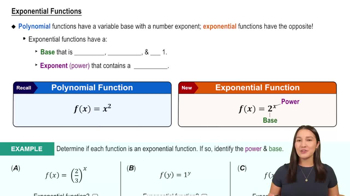Let ƒ(x) = x²⸍³ . Show that there is no value of c in the interval (-1, 8) for which ƒ' (c) = (ƒ(8) - ƒ (-1)) / (8 - (-1)) and explain why this does not violate the Mean Value Theorem.
Table of contents
- 0. Functions7h 54m
- Introduction to Functions16m
- Piecewise Functions10m
- Properties of Functions9m
- Common Functions1h 8m
- Transformations5m
- Combining Functions27m
- Exponent rules32m
- Exponential Functions28m
- Logarithmic Functions24m
- Properties of Logarithms36m
- Exponential & Logarithmic Equations35m
- Introduction to Trigonometric Functions38m
- Graphs of Trigonometric Functions44m
- Trigonometric Identities47m
- Inverse Trigonometric Functions48m
- 1. Limits and Continuity2h 2m
- 2. Intro to Derivatives1h 33m
- 3. Techniques of Differentiation3h 18m
- 4. Applications of Derivatives2h 38m
- 5. Graphical Applications of Derivatives6h 2m
- 6. Derivatives of Inverse, Exponential, & Logarithmic Functions2h 37m
- 7. Antiderivatives & Indefinite Integrals1h 26m
- 8. Definite Integrals4h 44m
- 9. Graphical Applications of Integrals2h 27m
- 10. Physics Applications of Integrals 3h 16m
- 11. Integrals of Inverse, Exponential, & Logarithmic Functions2h 31m
- 12. Techniques of Integration7h 41m
- 13. Intro to Differential Equations2h 55m
- 14. Sequences & Series5h 36m
- 15. Power Series2h 19m
- 16. Parametric Equations & Polar Coordinates7h 58m
4. Applications of Derivatives
Differentials
Problem 49
Textbook Question
Equal derivatives Verify that the functions f(x) = tan² x and g(x) = sec² x have the same derivative. What can you say about the difference f - g? Explain.
 Verified step by step guidance
Verified step by step guidance1
Step 1: Begin by finding the derivative of f(x) = tan² x. Use the chain rule, which states that the derivative of a function h(u) = u² is h'(u) = 2u * u'. Here, u = tan x, so u' = sec² x.
Step 2: Apply the chain rule to f(x) = tan² x. The derivative f'(x) = 2 * tan x * sec² x. This is because you differentiate tan² x as if it were (tan x)², using the chain rule.
Step 3: Now, find the derivative of g(x) = sec² x. Use the derivative rule for sec x, which is sec x * tan x. Therefore, the derivative g'(x) = 2 * sec x * sec x * tan x = 2 * sec² x * tan x.
Step 4: Compare the derivatives f'(x) and g'(x). Notice that both derivatives are equal: f'(x) = 2 * tan x * sec² x and g'(x) = 2 * tan x * sec² x.
Step 5: Since f'(x) = g'(x), the difference f(x) - g(x) is a constant function. This is because if two functions have the same derivative, their difference is a constant. Therefore, f(x) - g(x) = C, where C is a constant.
 Verified video answer for a similar problem:
Verified video answer for a similar problem:This video solution was recommended by our tutors as helpful for the problem above
Video duration:
4mPlay a video:
Was this helpful?
Key Concepts
Here are the essential concepts you must grasp in order to answer the question correctly.
Derivatives
A derivative represents the rate of change of a function with respect to its variable. It is a fundamental concept in calculus that allows us to determine how a function behaves locally. The derivative of a function f(x) at a point x gives the slope of the tangent line to the curve at that point, indicating how f(x) changes as x changes.
Recommended video:

Derivatives
Trigonometric Functions
Trigonometric functions, such as tangent (tan) and secant (sec), are essential in calculus, particularly in relation to angles and their properties. The function tan(x) is defined as the ratio of the opposite side to the adjacent side in a right triangle, while sec(x) is the reciprocal of cosine. Understanding these functions and their derivatives is crucial for solving problems involving angles and periodic behavior.
Recommended video:

Introduction to Trigonometric Functions
Difference of Functions
The difference of two functions, f(x) - g(x), provides insight into how the two functions compare at any given point. If f and g have the same derivative, it implies that their rates of change are identical, but they may differ by a constant. This concept is important for understanding the relationship between functions and can help in analyzing their behavior over an interval.
Recommended video:

Exponential Functions

 5:53m
5:53mWatch next
Master Finding Differentials with a bite sized video explanation from Patrick
Start learningRelated Videos
Related Practice
Textbook Question
